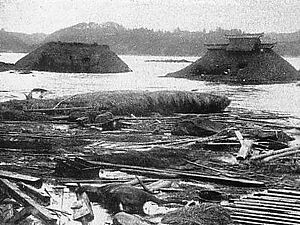Sanriku Coast facts for kids
The Sanriku Coast (which in Japanese is called Sanriku Kaigan) is a long stretch of coastline in northeastern Honshū, Japan's main island. It faces the Pacific Ocean. This beautiful coast runs through the southern part of Aomori Prefecture, all of Iwate Prefecture, and the northern part of Miyagi Prefecture. The name "Sanriku" means "three riku" and comes from three old Japanese areas: Rikuō, Rikuchū, and Rikuzen.
Exploring the Sanriku Coast
The Sanriku Coast is a popular place for tourists because of its amazing natural beauty. You can find several special parks here that protect the environment and offer great views. These include the Tanesashi Coast, the famous Rikuchu Kaigan National Park, and the Minami-Sanriku Kinkazan Quasi-National Park. These parks are perfect for exploring the unique coastline and enjoying nature.
Understanding Earthquakes and Tsunamis
The Sanriku Coast has a special shape called a "ria coastline." This means it has many narrow bays and inlets that look like fingers reaching into the land. While these bays are beautiful, they can also make tsunami waves much more powerful and destructive. When a tsunami enters these narrow bays, the water gets pushed higher and moves faster, causing more damage to the towns along the coast.
Over many years, the Sanriku Coast has experienced several very large earthquakes and tsunamis. These natural events have greatly impacted the communities living there. Some of the most significant events include:
- The 869 Jogan Sanriku earthquake
- The 1611 Keicho Sanriku earthquake
- The 1896 Meiji Sanriku earthquake
- The 1933 Showa Sanriku earthquake
- The 1960 Valdivia earthquake (which caused a tsunami that traveled across the Pacific Ocean from Chile)
- The 2011 Tōhoku earthquake and tsunami
Before the huge tsunami in 2011, people thought that new buildings and safety plans were making tsunamis less dangerous for people. However, the 2011 disaster showed everyone that tsunamis can still be incredibly powerful. It helped scientists and communities learn even more about how to prepare for these natural events.
More About the Region
- Sanriku Railway
- Sanriku, Iwate
- Tōhoku region



